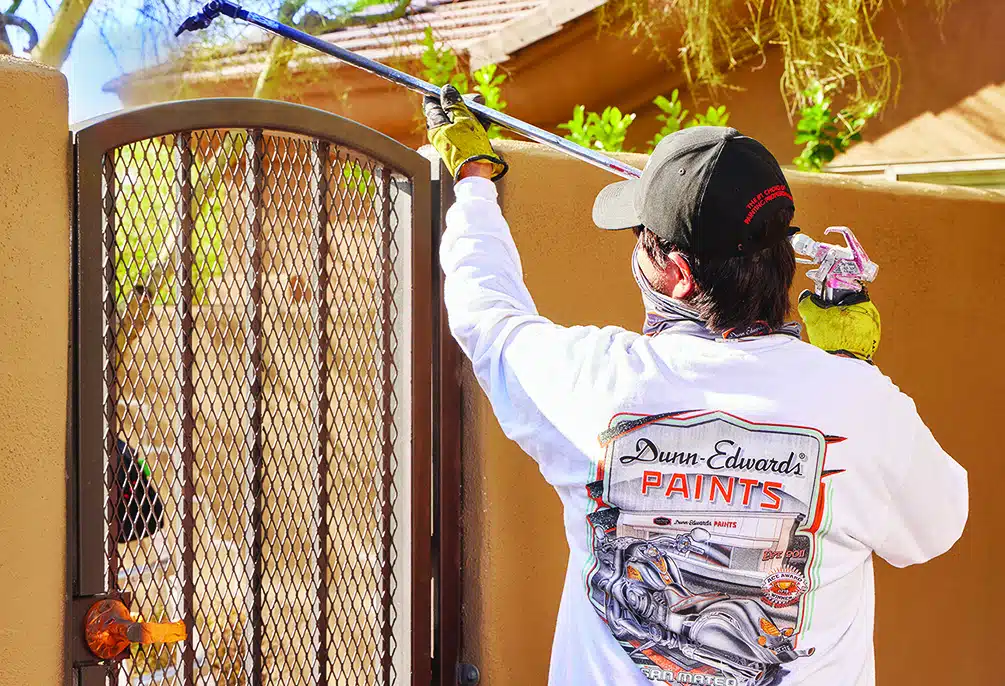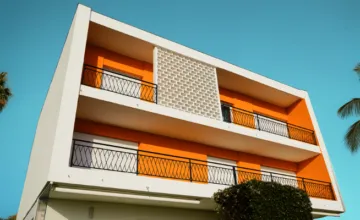Paint Fresh Stucco — The Right Way
07/11/2015 | Dunn Edwards |

For example, manual hydration and/or rainfall can help lower the pH level and speed up the curing process. Therefore, the most important dynamic is the extent of the stucco's curing and its pH level, not the amount of time elapsed since the stucco was applied.
Painting Stucco
Because stucco is hydrophobic, water is a vital catalyst in the chemical reaction that helps this material harden and cure — and is why it is recommended that it be moist-cured over a number of days, as it keeps the cement's moisture high enough to hydrate or cure.
Freshly applied stucco tends to be highly alkaline or have a high pH. pH is the scale by which we measure acidity (0-7 on the scale) or alkalinity (7-14 on the scale). When first applied, new stucco can have an alkalinity as high as 13 but — as it cures — the reaction binds the lime in the mix and causes the pH to drop. For the reaction to continue and full curing to occur, it must have water. Most manufacturers don't recommend painting stucco unless the pH level is 10 or below. If properly hydrated, stucco will easily attain a pH in the range of 8 or 9, if properly hydrated.
So what happens if paint is applied to stucco when the pH balance is too high? Most commonly, a "burning" may occur, which may appear as a dulled sheen or mottling of the coating and, eventually, leads to paint deterioration. At this point, it's best to realize that the damage is done, as the further addition of water may aggravate the situation and cause chipping and delamination.
Unfortunately, there is no "magic number" when it comes to how many days a fresh wall of stucco needs to cure for the pH level to drop to an acceptable level. That said, we can provide best practices regarding the optimal procedures to help ensure the paint job goes smoothly.
As mentioned earlier, stucco hydration is influenced by many factors, including humidity, temperature, wind and direct sunlight. Therefore, proper hydration is vital when preparing a stucco surface for paint. To hydrate a wall, apply water with an even spray over the entire surface until it begins to run off. Allow the wall to absorb the water and repeat several times. The surface may need to be hosed several times per day for several days. The need for additional wetting can be dictated by the exposure conditions, wind, humidity, temperature and orientations. For example, south- and west-facing walls may require more than north- or east-facing walls. Continue to hydrate the surface until it lowers to the desired pH level.
The most commonly used method to determine pH is with a pH pencil (which can be obtained from most paint distributors) and distilled water. Scratch a small area on the test surface and wet it with distilled water. A color chart is provided to match the color of the test area with the corresponding pH color level.
Another best practice is to prime stucco before painting, as primer functions as an intermediary between the stucco and coating. It also stops stucco from drawing moisture from the coating and discoloring it. A good, alkali-resistant primer will help your coating provide greater coverage and better performance.
Dunn-Edwards [PRODUCT#ESPR00] can be applied to new stucco with a pH level of 13 or lower. Hairline cracking is very common with new stucco, which can allow moisture to penetrate and activate any residual salts. These salts can migrate to the paint surface and attack the coating. Dunn-Edwards FLEX-PRIME® Masonry Primer can help to bridge these cracks and stay flexible to minimize future cracking. For additional protection, top-coating the alkali-resistant primer with an ultra-premium finish such as Dunn-Edwards [PRODUCT-PAGE#evershield] Ultra-Premium Exterior Paint will also promote color retention and minimize burnout. Spray application and back rolling will produce optimal results, as it forces the coatings into the stucco and fills voids that may allow moisture penetration and alkali migration to the surface.














